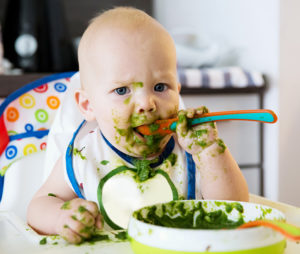One of the most common concerns I hear from parents regards their children’s bowel movements. From the newborn period through early childhood and later, children’s stools constantly change in content, texture, and frequency. Parents often don’t know what’s normal and when to be concerned. Here is a guide to help you troubleshoot whether your child’s stool is typical or if there’s something you should address with the doctor.
Newborns: Colors, Consistency, and Frequency
The first type of stool that you see after your baby is born is called meconium. This substance is black and tar-like and only lasts a few days. As the baby starts to eat, the stool transitions from black to dark green, to light green, to a seedy yellow substance that looks like deli mustard (sorry, we pediatricians love to compare gross things to food). This color and texture will continue for quite a while until you introduce solid foods between 4 and 6 months.
The frequency of newborn stooling varies and can change for no apparent reason. Anywhere from 8 to 10 stools each day to once every 5 to 7 days is considered normal. As long as frequent poopers do not have watery stools and infrequent poopers do not have hard, formed stools, you should be fine. Also, your baby may start out as a 10-times-a-day pooper and switch to once a day and vice-versa. This is typically not concerning. However, don’t hesitate to speak with your child’s physician if things seem abnormal.
Parents often become concerned about their baby’s comfort when they have not pooped for a few days. Babies can become quite gassy in these cases. This condition is usually not concerning, even if the stool comes out in a squishy explosion after 5 to 7 days. Having said that, if your baby is miserable and refusing to eat, it is acceptable to use one-half of a pediatric glycerin suppository to relieve the discomfort. If you find you have done this more than once, tell your baby’s doctor.
There should never be red or black in the stool; those are signs of blood. Stools should never look completely white. These colors warrant a call to your physician. As the intestinal environment matures in your child, you may notice days of green or brown in addition to yellow. I would consider all of these colors typical.
Parents often tell me they think their newborn is in pain during stooling. Most likely, this is not true “pain.” Babies certainly do not like to stool or pass gas.
My favorite analogy is this: try to picture defecating while lying on your back without any abdominal tone. It doesn’t sound pleasant, right? Babies tend to be extra gassy in the first few months as their intestinal environment matures. Please know that while gas pain is unpleasant, it is not dangerous or damaging, and babies typically grow out of this issue after the first few months. It is fine to try gas drops like simethicone or gripe water, but keep in mind that while safe, these are not miracle medications. There are infant probiotics available as well, and there is some soft evidence that this may help. You can try abdominal massage or bicycle kicks to help things pass. Probably the most important thing you can do is shower your baby with smiles and love.
Older Babies: A Changing Diet
As you introduce solid foods, baby’s minimally smelly, yellow, seedy stools slowly become the stinky poop that we all know. Remember that what what goes into your baby’s body is what comes out. If your baby chows down on peas and carrots, you likely see all of these foods in the stool. Don’t worry that the food looks undigested; this is normal. Your child’s stool will probably look different daily.
Keep in mind that some foods such as apples, bananas, and carrots are more constipating than others. If your child’s stools appear more formed, it might be time to serve them additional water in a sippy cup.
As you advance your child’s diet, you will see the frequency of stooling change. If stools are getting firmer, in addition to extra water, you might try what I call the “poop fruits” — prunes, peaches, and pears — to help with loosening. It may take some trial and error, but a bit of experimentation will help you find a good mix of foods to help your child stay. regular.
Children: Keep on Tracking
As your child grows, bowel movements should generally be smooth and soft, formed but not too bulky. Stools should come out easily, without pain or too much effort. Frequency is generally daily, but some children go multiple times per day and others every 2 to 3 days.
Stools in older children are generally brown, but the “what goes in comes out” rule still applies. If your child is sick and only eating crackers, the stool may look lighter or more green. Intense colors like food coloring and beets will come out the same. Yes, you may see that blue cupcake icing again in the toilet! Some foods, such as tomato and corn, may still come out looking whole and undigested.
Constipation is one of the most common causes of abdominal pain in childhood. Constipated poop looks like little balls or very bulky and rocky. If your child’s stool has these characteristics and associated abdominal discomfort, they are most likely constipated. Adjusting the mix of “poop fruit” (see above), fiber, and fluids is an excellent first step. This is the one circumstance in which pediatricians will recommend juice; prune or apple juice may be helpful. Also, because we live in a dry environment, making sure your child is drinking enough water may be all it takes to get things back to normal.
If these dietary interventions are not helping or have helped soften the stool but abdominal pains continue, this would be a good reason to see your child’s physician. For all significant abdominal pain complaints, don’t wait; make an appointment with the doctor.
I hope that this brief primer on pooping has helped you feel more confident in managing this part of your child’s health and well-being.
About Pediatrics at Boulder Medical Center
 The Boulder Medical Center pediatrics department is one of the largest practices in the area with clinics in Boulder, Louisville, Longmont and Erie, Colorado. Our board-certified pediatricians are committed to providing personal, high-quality and compassionate health care for newborns to young adults.
The Boulder Medical Center pediatrics department is one of the largest practices in the area with clinics in Boulder, Louisville, Longmont and Erie, Colorado. Our board-certified pediatricians are committed to providing personal, high-quality and compassionate health care for newborns to young adults.
Click here to meet our pediatric team
The information provided in this article is intended for your general knowledge only and is not a substitute for professional medical advice or treatment for specific medical conditions. You should not use this information to diagnose or treat a health problem or disease without consulting with a qualified healthcare provider. Please consult your healthcare provider with any questions or concerns you may have regarding a medical condition.


